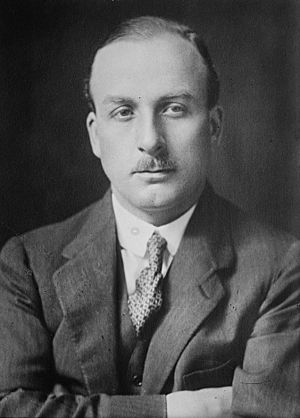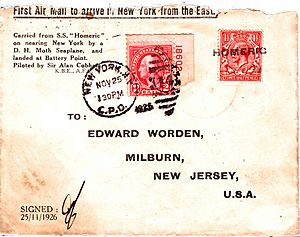Alan Cobham facts for kids
Quick facts for kids
Alan Cobham
|
|
|---|---|
 |
|
| Born |
Alan John Cobham
6 May 1894 London
|
| Died | 21 October 1973 (aged 79) Bournemouth; Dorset
|
| Nationality | English |
| Occupation | Aviator |
Sir Alan John Cobham (born May 6, 1894 – died October 21, 1973) was a famous English pilot. He was a true pioneer in aviation, meaning he was one of the first to do many important things in flying. He helped make air travel popular and safer for everyone.
Contents
Early Life and Family
Alan Cobham went to Wilson's School in London when he was a child. In 1922, he married Gladys Lloyd. They had two sons, Geoffrey and Michael. Michael later followed in his father's footsteps, working in the aviation business.
Amazing Flying Adventures
Alan Cobham was a pilot in the Royal Flying Corps during World War I. After the war, he became a test pilot for the de Havilland aircraft company. He was known for his incredible long-distance flights.
Exploring Europe by Air
In 1921, Alan Cobham took a three-week air tour of Europe. He visited 17 cities and flew 5,000 miles! This showed how useful airplanes could be for travel.
Flights to Far-Off Lands
Between 1925 and 1926, he flew from London all the way to Cape Town, South Africa, and back. He used his special de Havilland DH.50 plane for this journey.
In 1926, he made another huge flight from Britain to Australia. When he landed in Melbourne, 60,000 people came to see him! Sadly, during the flight, his engineer, Arthur B. Elliot, passed away after they left Baghdad. After these amazing flights, Alan Cobham was made a knight.
Mail Delivery Challenge
Later in 1926, Sir Alan tried to be the first person to deliver mail to New York City by air from the east. He planned to fly mail from a large ship called the RMS Homeric. But the water was too rough for his small plane to take off. He had to be towed into the harbor by the ship. Even so, he was given a gold medal for his achievements in aviation.
Flying Around Africa
From 1927 to 1928, he flew a special plane called a flying boat all around the continent of Africa. He only landed in places that were part of the British Empire at the time. Sir Alan also appeared as himself in a British film about flying called The Flight Commander.
Encouraging Air Travel in Britain
In 1929, Sir Alan started a special tour of Britain. He wanted to encourage towns to build their own airports. He would offer free flights to important local people and even to schoolchildren! A man named Sir Charles Wakefield paid for thousands of these flights for kids. Sir Alan used a large plane called the de Havilland DH.61 Giant Moth, which he named "Youth of Britain." He visited 110 towns and showed everyone how exciting flying could be.
Cobham's Flying Circus
In 1932, he started something even more exciting: the National Aviation Day displays. People often called it "Cobham's Flying Circus!" This was a team of many different airplanes and skilled pilots. They traveled all over the country, putting on amazing air shows. Thousands of people got to experience flying for the very first time. This helped many people become interested in airplanes and air travel. The shows were so popular that sometimes there were two tours happening at the same time!
Innovations in Aviation
Sir Alan was also involved in starting an aircraft company called Airspeed Limited. He helped them by ordering some of their first planes. He also worked on new ideas for refueling planes while they were still in the air. This meant planes could fly much longer distances without landing. These ideas became very important later, especially during World War II.
Sir Alan Cobham once said, "It's a full time job being Alan Cobham!" He retired to the British Virgin Islands but later returned to England, where he passed away in 1973.
In 1997, he was honored by being added to the International Air & Space Hall of Fame. The company he started, Cobham plc, is still a big part of the aviation industry today.
Images for kids




